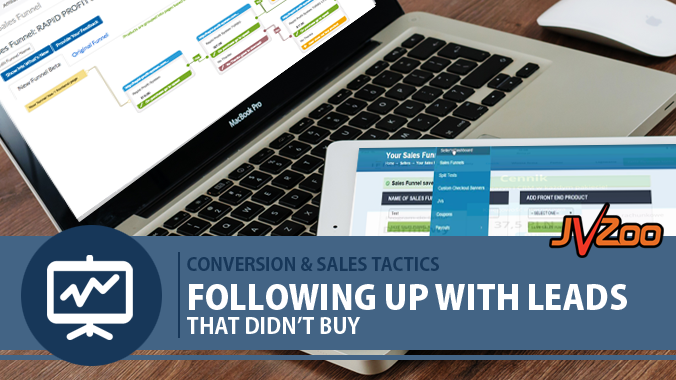One of the first things someone hears upon entering the sales arena is, “The Fortune Is In The Follow Up”. This is true regardless of what type of sales profession you are in, from retail sales to internet marketing.
It is also one of the least favorite and neglected aspects of the sales process, for some reason. Below, we will talk about the reasons for following up with leads who didn’t make a purchase initially, and strategies to use when doing so.
Not following up with someone who doesn’t make a purchase the first time they visit your website, abandon their shopping cart, or you send them an email is a huge mistake. Every time you do this, you could be throwing away substantial amounts of money.
It’s pretty widely accepted, in fact, that an individual will typically need to be exposed to a product’s advertisement or message an average of seven times before they will decide to take the action required to buy the product or service being offered. This is called the ‘Rule of 7’ and is one of the oldest concepts in marketing.
While the number seven isn’t set in stone, a person will more than likely need to be exposed to your offer more than once before deciding to buy it. This can be for any number of reasons, such as:
They Don’t Know, Like, & Trust You Yet – Perhaps your prospective client really is interested in your product from the get-go, but they have only just opted-in to your list. It’s possible that they simply need time to get to know you as a marketer and as a person before they will feel comfortable enough to give you their money.
People are exposed to so many ads, emails, sales pages, and lead capture forms nowadays, that they tend to be a bit skeptical of the marketers behind them. Maybe they have been taken advantage of in the past by someone who didn’t follow your strict code of ethics. Maybe they are new to the online marketing arena. Whatever the case, building trust takes time and is the biggest obstacle to making sales online.
They Didn’t Have An Immediate Need For Your Offer – Another reason one might not make a purchase the first time they are introduced to your offer is that they simply aren’t in the need of it, yet. By following up with them, you will place yourself in position to be the one they remember when they actually DO need what you’ve got to offer.
Distractions – People are busier than ever. Many times we start a task only to be distracted and forget to go back to it later. Things that we mean to do simply get forgotten in our hectic, fast-paced lifestyle. It’s not intentional. Your follow-up messages will help those who meant to purchase or put it off, the chance to follow through with their plan.
They’re Just Not Convinced Yet – This is another area in which your reputation as someone who provides exceptional value comes in. The more a person knows and trusts you to be the one who will give them the most bang for their buck, the quicker they will be to buy your product or service. This also takes a bit of time and wooing, but once you’ve achieved it, the rewards will speak for themselves.
Now that we’ve covered some of the reasons for following up, let’s touch on some ways to do it effectively:
Swipe Emails: If you are an affiliate, you have most likely been given swipe emails at one point or another. These are a great resource if used correctly. What we see a lot of times, though, are emails that have been copied and pasted without any type of editing or changes to make them more unique to the marketer sending them. If you are guilty of doing this – Stop. Now.
Even if you are sending seven follow up messages on the same product or service, they need to be different. You cannot develop a sense of trust with your list if they see that you’re simply a copy & paste expert. In fact, it’s a bit insulting. These are people whom you have (hopefully) targeted because of their unique set of wants and needs. Don’t treat them like a number on your list.
Make your emails stand out from the others by injecting them with your own personality, word choices, and unique connection to your subscribers. There is no quicker way to entice your list members to hit the delete button on an unread email faster than having the same subject line as 10 other marketers in their inbox. Dare to be different.
Use A Survey – A smart way to learn exactly why people aren’t buying is to ask them! Send out a survey to your list requesting their input on a product that didn’t get your anticipated amount of sales. This will give you excellent insight as to where they stand, what they are looking for, and why they didn’t buy a particular product.
Create Urgency – This sales tactic will need to be used intelligently and only when a product’s sale price, bonus, or availability is coming to an end. Too many times, marketers send out a “This is your last chance!” email when it wasn’t truly the last chance for anything. Not cool! Make sure you are being honest at all times, but also be sure to employ this type of email when it is actually warranted. The best time to send this type of email is about 24 hours before your sale, bonus, or trial period ends.
Avoid Being Too Aggressive – Space your follow up emails out unless your list is accustomed and receptive to receiving a ton of daily sales emails from you. Your follow-up emails should typically be reminders, or be a part of a series that highlights the different benefits of the product/service you are offering. Always strive to come across as helpful instead of pushy and desperate.
Now, armed with this information, make it a point to focus on your follow up. You’ll be surprised how much your sales can improve by simply not giving up if someone doesn’t buy the first time they see your message.

